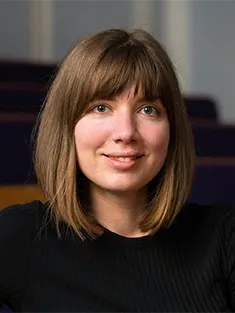Winner: 2023 Materials Chemistry Early Career Prize
Professor Ludmilla Steier
University of Oxford
For seminal contributions to the understanding of defect chemistry in semiconducting materials and interfacial energetics in photocatalytic and photovoltaic devices.

We urgently need to transition to a circular sustainable economy if we want to succeed in mitigating the impacts of climate change and protecting our ecosystem. At the core of this transition is the ability to store and use renewable energy: solar energy, in particular, since the sun is the most abundant renewable energy source available to our planet. Professor Steier’s group develops materials that can use solar energy to make energy-rich and therefore high value chemicals, such as hydrogen, ethylene and methanol, from water and atmospheric carbon dioxide. The chemicals can function as a fuel (and a form of energy storage) as well as a chemical feedstock for various branches of the chemical industry. Using a technique called atomic layer deposition (ALD), coupled with material characterisation carried out during catalysis, the group links material properties with catalyst performance, which is key for the development of the next generation of materials.
Biography
Ludmilla Steier is Associate Professor of Inorganic Chemistry and Goodenough Tutorial Fellow at Saint Catherine’s College, University of Oxford. She obtained her BSc and MSc degrees from the University of Siegen (Germany). During her undergraduate studies she developed an interest in electrochemistry and semiconductor physics. As a result, she pursued an MSc project on dye-sensitised solar cells in the group of Professor Michael Grätzel at the École Polytechnique Fédérale de Lausanne (EPFL, Switzerland). While in the same group, Ludmilla worked on oxide thin film photoelectrodes applied in photoelectrochemical water splitting and perovskite solar cells during her PhD degree which she obtained in 2016. Ludmilla joined the group of Professor James Durrant at Imperial College London to study photochemical and photophysical processes in semiconductors using time-resolved spectroscopy. Shortly after, she was awarded the Marie Skłodowska-Curie Fellowship (2017–2019). She then began her independent research career as Imperial College Research Fellow (2019–2021) before moving to Oxford in October 2021. Her research at Oxford focuses on the design of atomically defined photo- and electrocatalysts that convert CO2, water and other ‘waste products’ to energy-rich fuels and chemicals with high conversion efficiency, selectivity and long operational stability.
Q&A with Professor Ludmilla Steier
How did you first become interested in chemistry?
I believe in 6th or 7th grade, a number of experiments in the chemistry (and physics) classes resonated with me. One of the first ones I still vividly remember turned white anhydrous copper sulphate powder into the most beautiful blue with just a drop of water. Like magic, some of my friends said (probably because we were reading Harry Potter at the time), but I wanted to understand what caused the change in colour. This had to wait for a little since MO theory was unfortunately not part of the school curriculum :). This particular blue is still my favourite colour. I think colours, pigments and the interaction of light with matter have always fascinated me. What motivates you? I think there are day-to-day things that motivate me that I perceive as an external motivation and then there is a drive that I think comes from within. The day-to-day things are important as they are stimulating and exciting. This could be the happy moment when we collected data from a series of long experiments followed by the moment of truth when we look at the data and realise the outcome is unexpected. This demands further experiments for clarification and a new cycle of the project starts. Equally motivating I find the discussions with my group and fellow researchers, especially the moment when I recognise "the click" which is the moment in which either of us just got a better understanding, a different angle to look at a problem or a new idea – or, with some luck, all of the above.
The motivational driver from within is my ambition to contribute to our transition to renewable and, in particular, solar energy.
I hope that my research will help advance photo- and electrocatalysis with earth-abundant and hence scalable materials and grow our understanding of how their properties dictate their catalytic performance in order to design better catalysts. What does good research culture look like/mean to you? To me, good research culture enables everyone in the research community to reach their full potential to advance our understanding and technological development as a society through carefully designed and executed experiments and an unbiased and analytical interpretation of the results. I strongly believe that the best science is done when we can focus on the experiments and are then stimulated by discussions with the research community to interpret the results and deepen our understanding. I think that this focused state is easier achieved by a happy mind and that productive discussions can only occur when all parties feel positive about sharing their thoughts. Consequently, a good research culture should, in my opinion, create an environment that is inclusive, collaborative, open-minded, supportive, and most importantly respectful.Why do you think teamwork is important in science? It is much more fun to work in a team which I believe boosts our productivity and motivation, in particular if it is a challenging project. Often challenging projects lead to significant scientific breakthroughs and would be at risk of failure if the project is not carried by the multidisciplinary and complementary expertise, experience and knowledge of a team. Furthermore, teamwork creates a good research culture.